A modern kitchen is so much more than a place to cook. Growing up in a household that blended Polish traditions with Chinese philosophies, I learned early on that the kitchen is the nexus of family life—a space for nourishment, conversation, and connection. It’s where my Babcia’s heart-warming pierogi met my mother’s meticulously crafted dumplings. This fusion isn’t just about food; it’s about how design can honor different ways of living, side-by-side.
What I bring to my design work is this very idea of “thoughtful fusion.” It’s a way of looking at a kitchen not as a collection of appliances and cabinets, but as a meditation on how we live. It’s about creating breathing room, what the Japanese call ma (meaningful empty space), while also embracing the Polish concept of dom (the home as a true sanctuary). This isn’t about stark, cold minimalism. It’s about stripping away the noise to find what truly matters in our daily rituals.
So, let’s walk through the decisions that elevate a kitchen from simply modern to deeply personal. These aren’t just tips; they’re invitations to think about your space as a cultural ambassador for your own life.
1. Mastering the Open-Concept Kitchen (Without Losing Your Sanity)
Let’s start with the big one: the open-concept layout. I know it’s been a trend for years, but what really gets me is why it works so beautifully when done right. It’s not just about knocking down walls for the sake of it. From a more Eastern sensibility, it’s about allowing good energy, or qi, to flow freely. From my Polish side, it’s about making the heart of the home truly open to everyone. It collapses the old formal roles—the cook is no longer isolated but is part of the laughter, the homework, the very life of the home.
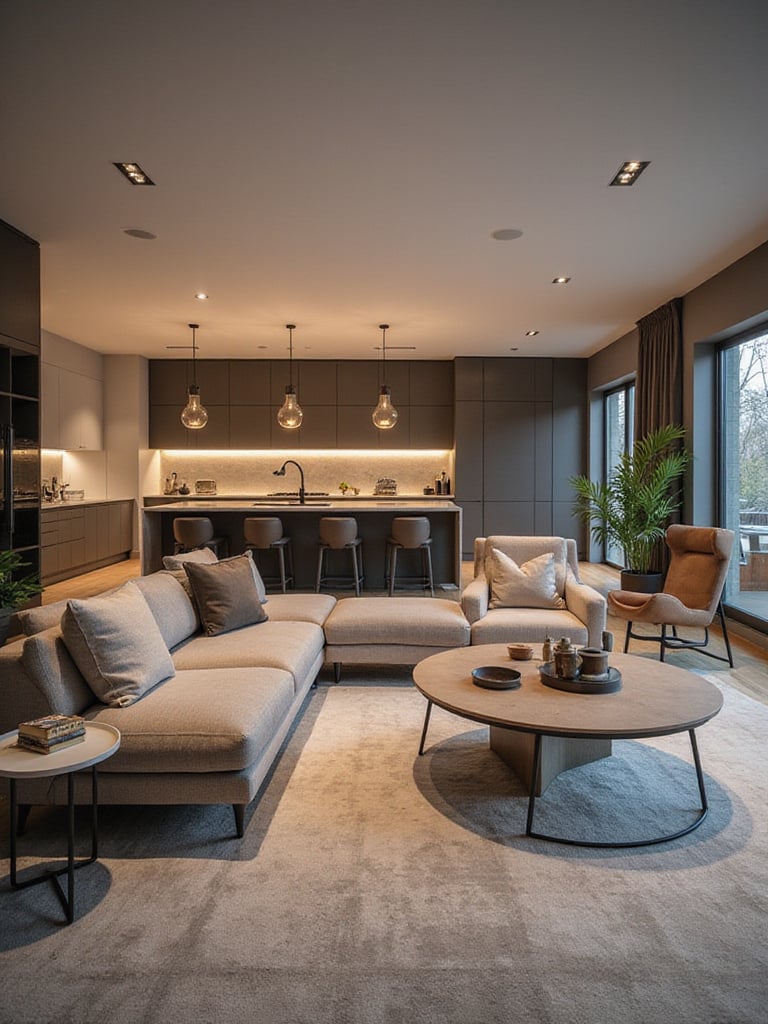
The secret here is creating what I call “invisible boundaries.” You need to define zones without building walls. How do you do that? Think about how traditional Chinese architecture uses subtle changes in floor level or ceiling height. Or how a Scandinavian design might use a consistent wood tone to unify a kitchen and living area. For a recent client, we used a single, magnificent slab of quartzite that began as the island countertop, cascaded down the side in a waterfall edge, and then continued as the flooring for the adjacent dining nook. It created this powerful anchor for the kitchen, clearly defining the space while keeping that expansive, welcoming feeling.
- Try This: Use a single flooring material from the kitchen into the next room to create an unbroken visual line. Use different styles of lighting to define a “cooking zone” versus a “relaxing zone.” Position your island or a peninsula to guide foot traffic naturally.
Defining the space visually is one thing. Now, let’s talk about the emotional atmosphere, which begins with color.
2. Defining a Color Palette That Actually Calms You
In a modern kitchen, color should feel like a well-composed haiku—every choice is deliberate, with enough negative space to let the important things breathe. I find the most resonant palettes draw from both the earthy, humble tones of traditional Polish Bolesławiec pottery and the quiet, sophisticated neutrals that are a hallmark of contemporary Asian interiors. The formula is simpler than you think: pick one dominant neutral (a warm white or soft grey), a supporting tone (maybe a muted green or earthy taupe), and just one accent that you sprinkle in sparingly.

And here’s the thing—this isn’t just about aesthetics. A restrained palette has a real psychological effect. Environments with less color variation can actually reduce our cognitive load, making us feel more centered and focused. In my own kitchen, the cabinets are a soft, greige-white. The only wood is the butcher block on one end of the island, and the single accent of color—a deep, inky blue—appears only in the stoneware mugs hanging on a rack and a single piece of abstract art. The goal isn’t a sterile lab; it’s a calm backdrop that makes the texture of the linen dishtowels and the glint of morning light on a steel faucet the real stars.
- A good rule of thumb: Stick to the classic 60-30-10 rule (60% main color, 30% secondary, 10% accent). Make sure your neutrals share a warm or cool undertone. Let texture, not color, create most of the interest.
With a calming backdrop set, we can focus on how you move within the space. Function is everything.
3. Designing a Workflow That Moves With You
Ergonomics. It sounds so technical, right? But it’s really just about designing a kitchen that fits your body and your habits, not the other way around. It draws from brutally efficient German engineering and the graceful, no-wasted-motion philosophy you see in Japan. A kitchen designed around your personal workflow can cut down on unnecessary steps and strained movements, turning the chaos of cooking into a fluid, almost meditative dance. This is where we throw out the rigid, old “work triangle” rule. It’s outdated.

True ergonomic design starts with a brutally honest assessment of how you actually use your kitchen. Do you chop vegetables while catching up with your partner? Are you right-handed or left-handed? One of my most memorable projects was for a passionate home baker who had a nagging shoulder injury. Standard counter height was agony for her when using her stand mixer. We designed a custom pull-out shelf in her island that lowered the mixer to the perfect height for her. It was a simple adjustment that completely transformed her joy of baking.
- Get Practical: Before you design anything, map out your movements during a typical meal prep. Where do you trip over yourself? Customize counter heights. Keep oils and spices right next to the stove, and knives and cutting boards by your main prep area. Simple, but it makes a world of difference.
This idea of streamlined movement leads us right into the aesthetics of cabinetry.
4. Choosing Sleek, Handleless Cabinets
Handleless cabinetry is the ultimate expression of this streamlined ethos. It creates these clean, uninterrupted planes that let the material itself do the talking. I see it as a beautiful intersection of the Japanese principle of shibui (subtle, unobtrusive beauty) and the Bauhaus idea that form must follow function. By removing the visual clutter of knobs and pulls, a kitchen can feel significantly larger. Plus, let’s be honest, they are so much easier to wipe down.
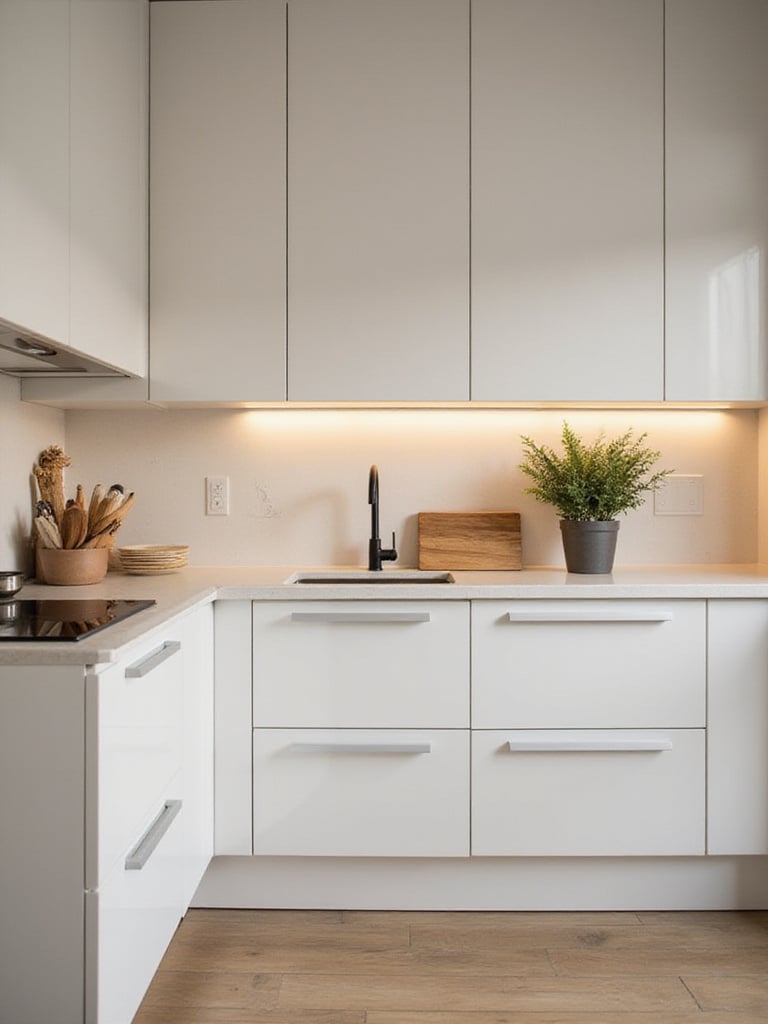
The technology for this has come a long way from the clunky push-latches of the past. You now have options from responsive push-to-open mechanisms to whisper-quiet electronic systems. What works best is often a mix. I like using push-to-open on upper cabinets you access less frequently, and integrated channel pulls (a recessed grip on the top or side of the door) for high-traffic drawers and doors. Material is key here. A glossy finish is stunning but shows every single fingerprint, while a matte Fenix finish is wonderfully forgiving and has a soft, sophisticated feel.
- Insider Tip: The German kitchen maker Bulthaup says the kitchen is “becoming more like a piece of furniture than a collection of appliances.” That’s exactly it. Handleless design is what gets you there.
These beautiful, clean cabinet fronts need an equally beautiful and functional surface on top.
5. Selecting Countertops for Real-Life Durability
Choosing a countertop is a huge commitment. It’s one of the most hardworking surfaces in your home, and it has to balance beauty with the harsh realities of daily life. Drawing on both European material science and Asian stone-working traditions, I’ve learned to prioritize materials that age gracefully and don’t demand constant babying. Engineered quartz is a workhorse—it gives you the look of natural stone without the anxiety of staining. Ultra-thin porcelain slabs are also incredible; they’re tough and offer design possibilities that were once unthinkable.
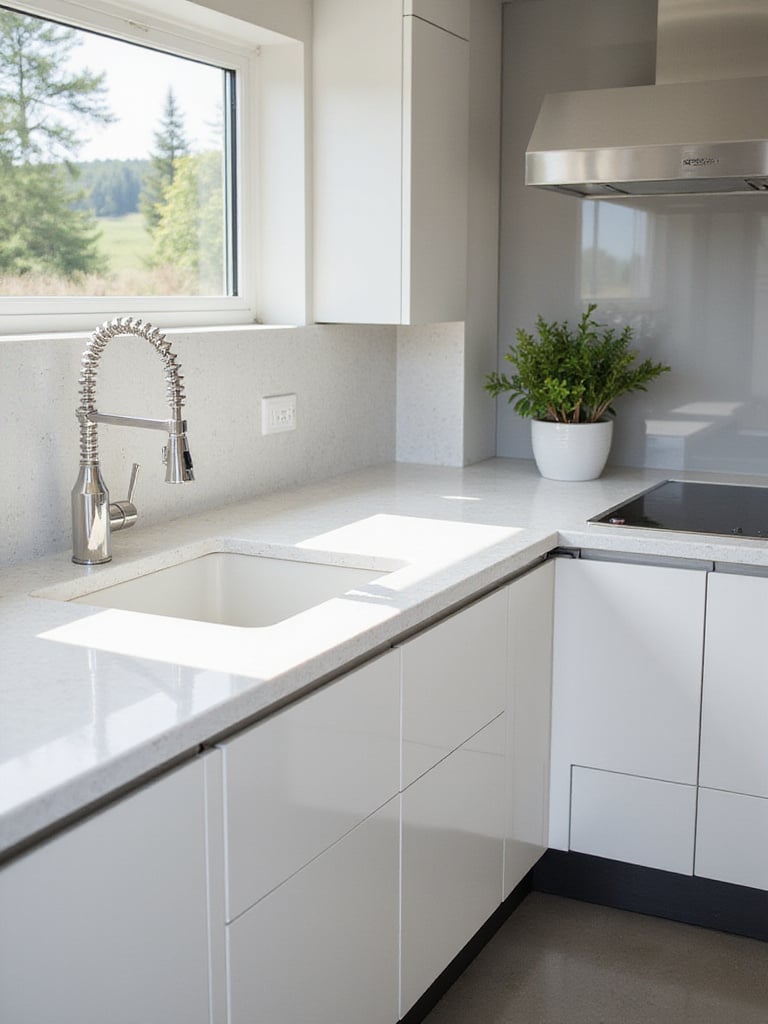
The best choice depends entirely on your lifestyle. If you make a lot of tomato sauce or use citrus daily, you might find that even sealed marble or concrete will etch over time. If you entertain constantly, maybe a solid surface that can be seamlessly repaired is a better bet. A few years ago, for a couple who loved dramatic statements, we used a book-matched porcelain slab with a bold black-and-gold vein that ran up the wall as a backsplash. It was pure theater. For another, more low-key family, we used a honed concrete that felt incredibly soft and calming.
- Don’t Forget: Test samples against heat and stains yourself. Be honest about how much maintenance you’re willing to do. And ask your fabricator about how the material can be repaired if something goes wrong.
From the countertop, our eyes travel down to the floor, which has to be just as resilient.
6. Installing Modern Flooring That Connects and Endures
Kitchen flooring has a tough job. It needs to be comfortable enough to stand on for hours, durable enough to handle dropped pots and endless foot traffic, and visually seamless enough to connect with the rest of your living space. The most successful modern floors I’ve designed blur the lines between inside and out. I love using large-format tiles or wide engineered wood planks that run continuously from the kitchen into the dining area, creating a flow that makes the whole space feel bigger.
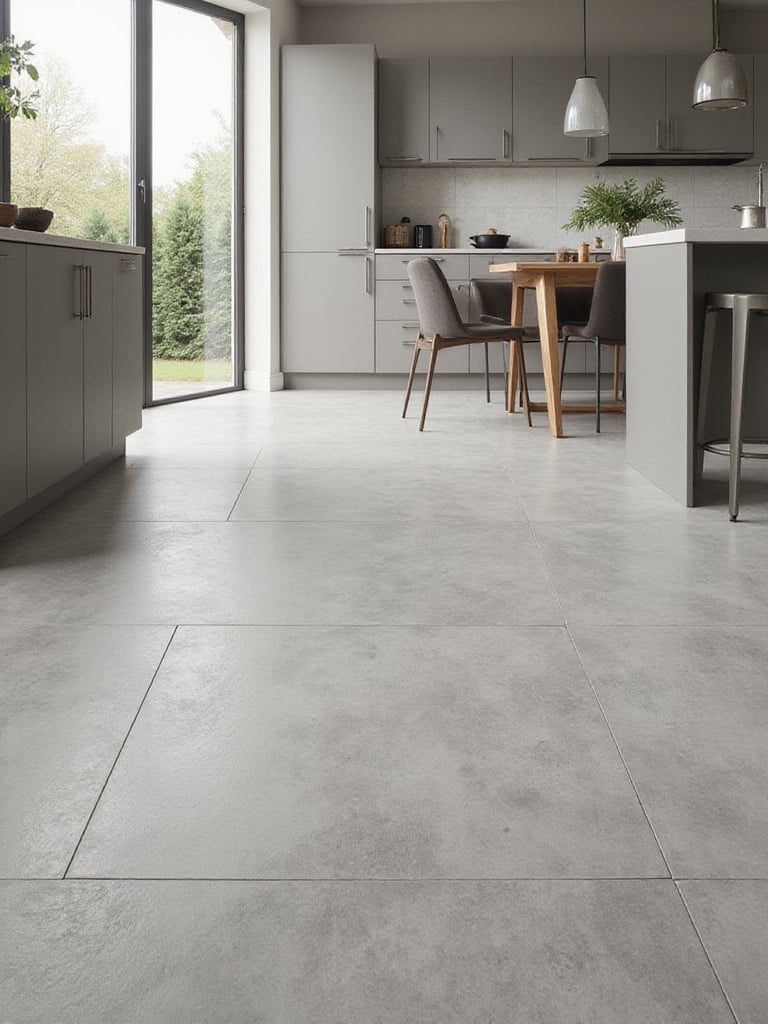
The technology in flooring is advancing so quickly. You can now get luxury vinyl planks that look and feel uncannily like real reclaimed wood but are completely waterproof. Or, there are impossibly thin porcelain tiles you can lay directly over an old floor with minimal fuss. In a challenging renovation where we wanted to connect the kitchen to a covered patio, we used massive concrete-look porcelain tiles with nearly invisible grout lines. The effect was stunning—it felt like one enormous, cohesive space.
- What to Look For: Larger format tiles or planks mean fewer grout lines to clean. Pay attention to the texture—you want some slip resistance without it being a nightmare to mop. And consider a floating floor if you think you might want to update it again in a decade.
Now we get to the fun part: the tech that makes a modern kitchen truly smart.
7. Integrating Smart Appliances for a Kitchen That Helps You
A smart kitchen isn’t about flashy gadgets or a fridge that talks to you. It’s about creating systems that learn your habits and anticipate your needs. This feels, to me, like a modern expression of the deep-rooted hospitality found in both Polish and Chinese cultures—thoughtfulness made tangible. A genuinely smart kitchen solves real problems: it helps you reduce food waste with inventory tracking, cook a perfect steak every time with precise temperature probes, and gives you peace of mind with automatic shut-off features.
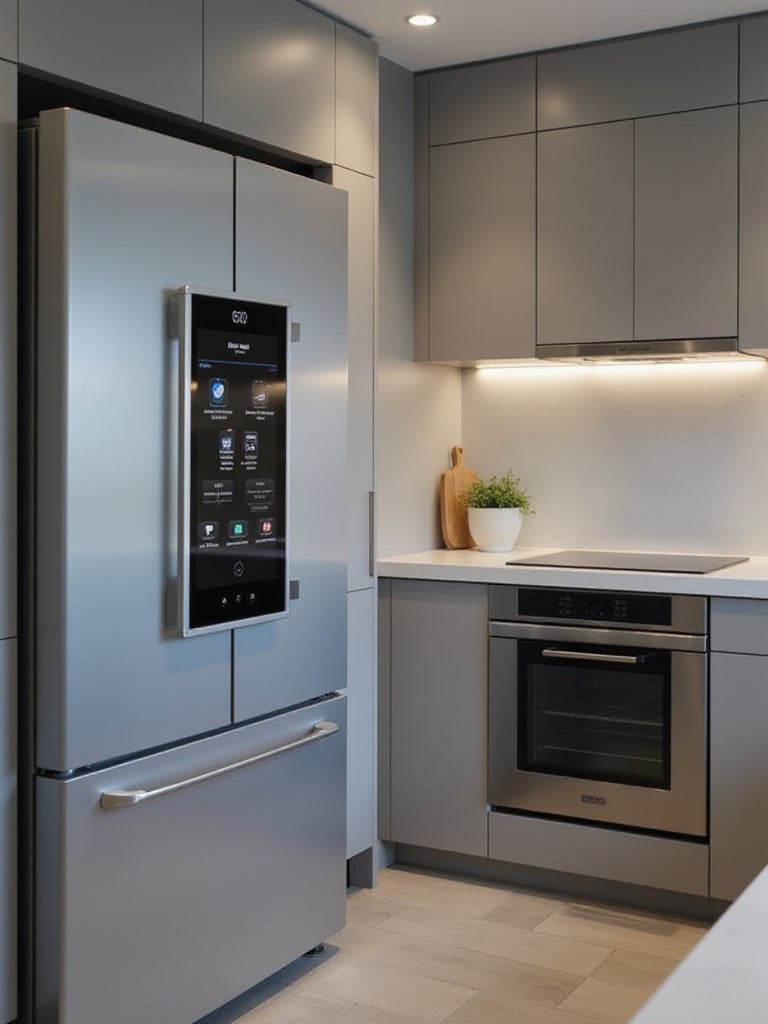
The key to a future-proof smart kitchen is to avoid getting locked into one brand’s ecosystem. Look for appliances that support open standards like Matter or Thread. This ensures your new oven can talk to your old dishwasher, and everything can be controlled from one place. Don’t feel you have to automate everything at once. Start with one or two things that will make the biggest impact on your daily life, like a quiet, efficient induction cooktop or a refrigerator that actually helps you use up what you have before it goes bad.
- Be a Smart Shopper: Prioritize connectivity standards over brand names. Check for integration with your existing smart home setup (like Google Home or Alexa). And always understand the privacy settings and what data is being collected.
Just as important as smart appliances is a smart approach to lighting.
8. Layering Your Lighting for the Perfect Mood
Lighting is everything. Your kitchen has multiple jobs, so its lighting needs to be just as versatile. It needs to be bright and energizing for your morning coffee rush, warm and intimate for a dinner party, and sharply focused for chopping onions. This layered approach is a blend of the Chinese principle of balancing yin and yang energies and the Scandinavian obsession with making the most of every drop of light. A well-designed lighting scheme can reduce eye strain and give you the power to completely transform the feel of the room with the flip of a switch.
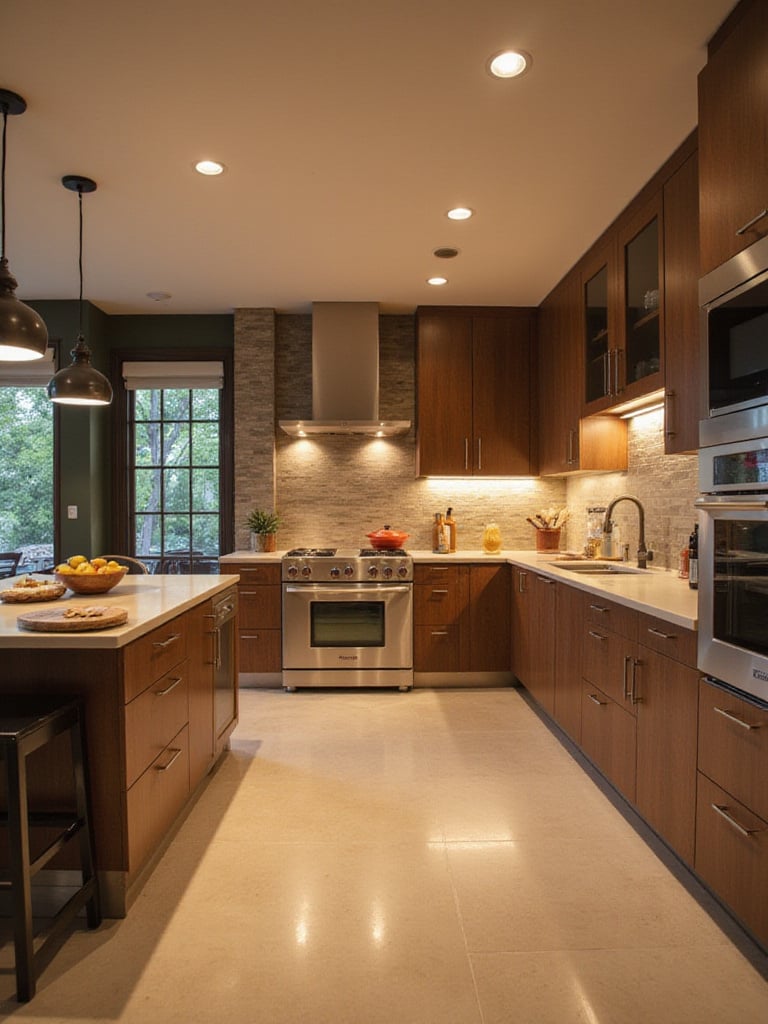
Every kitchen should have at least four layers of light: ambient (general, overhead lighting), task (focused lights under cabinets or over the island), accent (to highlight art or a beautiful backsplash), and decorative (a beautiful pendant that adds personality). LEDs have made this so much easier, especially with tunable white light that can shift from a cool, blue-ish tone during the day to a warm, candle-like glow in the evening. In my recent projects, I’ve been integrating circadian lighting systems that do this automatically, supporting your body’s natural rhythms.
- Non-Negotiables: Put dimmers on absolutely everything. Use cooler light (around 4000K) for task areas and warmer light (2700K–3000K) for ambiance. Create preset “scenes” that combine different layers for activities like “Cooking,” “Dining,” or “Cleaning.”
Let’s zoom in on a small detail with a huge impact on daily use and hygiene.
9. Adding a Touchless Faucet for Effortless Hygiene
The touchless faucet is the perfect marriage of modern health consciousness and graceful technology. After handling raw chicken, the last thing you want to do is smear germs all over the faucet handle. A touchless model eliminates that issue, offering a kind of seamless convenience that truly defines modern luxury. It’s not just a gadget; it’s a small change that makes the entire process of cooking and cleaning feel more fluid and hygienic.
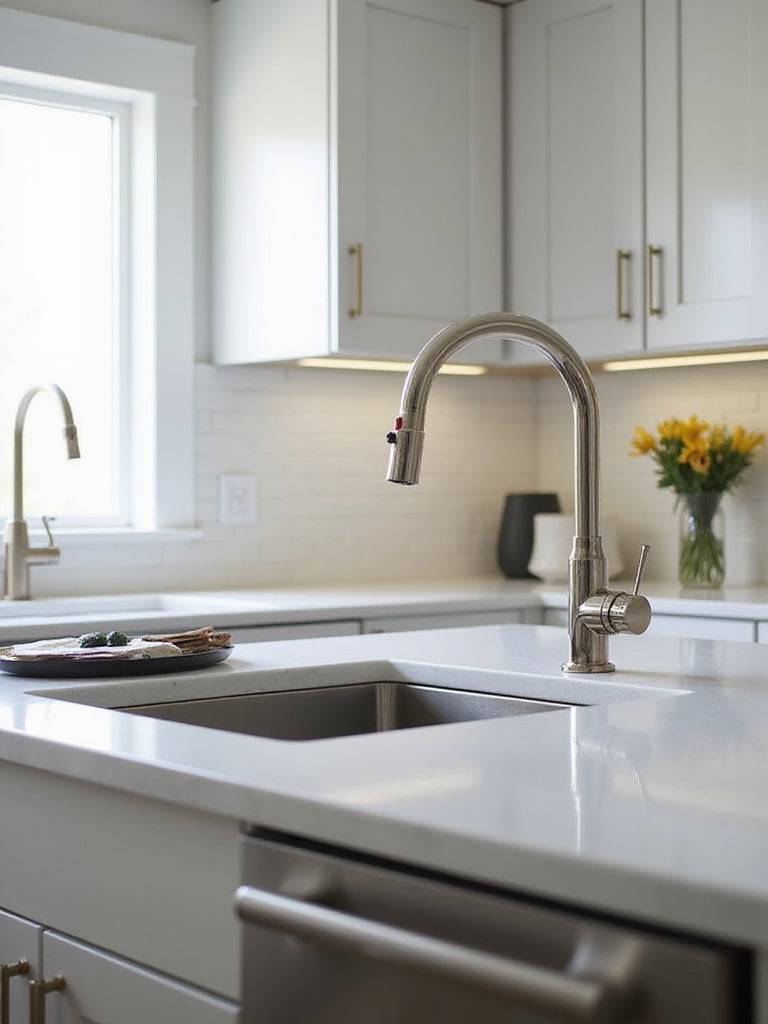
Early models could be finicky, but the technology is solid now. They have reliable sensors, long battery life, and often a manual override, just in case. And they’re not all chrome monstrosities anymore; you can find them in gorgeous, minimalist designs and finishes to match your other fixtures. The only real consideration is ensuring you have enough space under the sink for the small control box and battery pack. It’s a simple upgrade that you’ll appreciate a dozen times a day.
- A Personal Take: Kitchen designer Jennifer Gilmer nailed it when she said, “The beauty of touchless technology lies not in its novelty, but in how it disappears into the background of daily life.” That’s it exactly. It’s function so good, you stop noticing it.
From a functional detail to an artistic one: the backsplash.
10. Using a Statement Backsplash as Your Kitchen’s Art
Think of the backsplash as your kitchen’s canvas. In an otherwise minimalist space, this is your opportunity to inject personality and tell a story. This idea echoes the rich traditions of decorative tilework you see all over Europe and Asia, but with a contemporary twist. A great statement backsplash provides a focal point that enhances the whole room without overwhelming it.
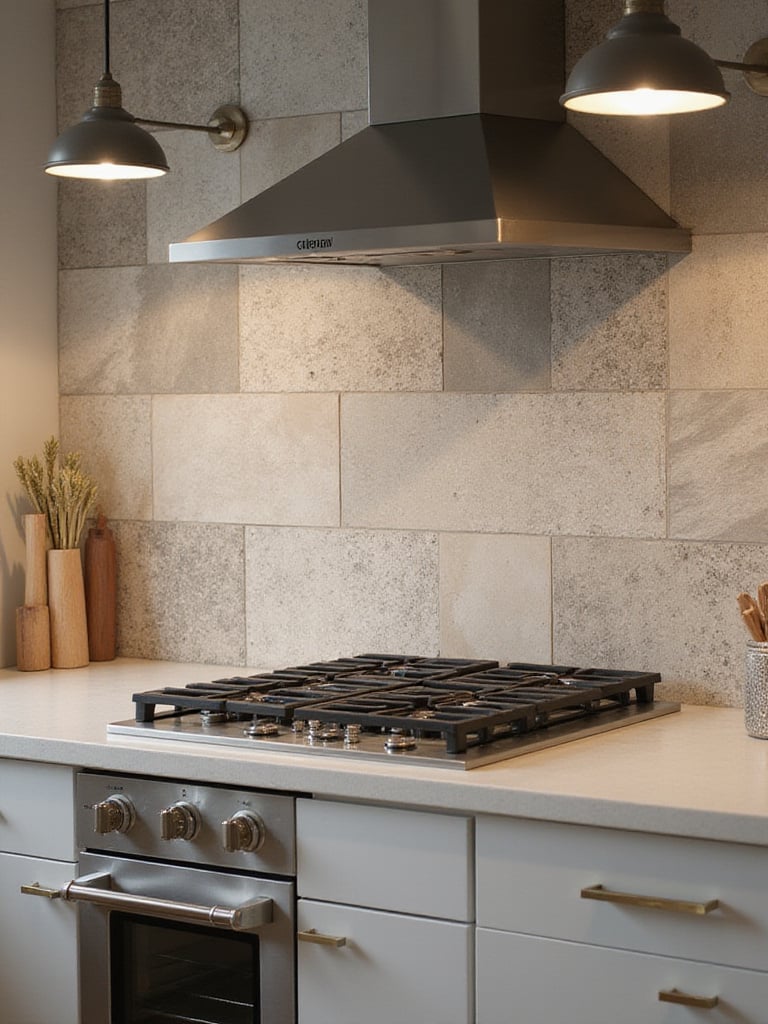
The key is balance. If your countertops have dramatic, busy veining, a quieter backsplash—maybe a textured ceramic tile in a single color—will provide a pleasing contrast. But if your counters and cabinets are serene and uniform, go for it! A slab of book-matched marble that extends all the way to the ceiling is breathtaking. One of my favorite projects used small, handmade zellige tiles from Morocco. Each one was slightly different, and the way they caught the light throughout the day was just magical.
- Pro-Tip: Pay attention to scale. A large-format pattern works best in a larger kitchen. Always choose a material that can stand up to heat, grease, and scrubbing. And for complex patterns, don’t skimp on a professional installer—it’s worth it.
Behind that beautiful backsplash, we need to get serious about storage.
11. Maximizing Hidden Storage to Banish Clutter for Good
Excellent storage is the quiet hero of a modern kitchen. It’s not just about hiding your mess; it’s about creating logical, accessible systems that keep the serene, clean-lined aesthetic intact. This is where Marie Kondo’s philosophy meets pragmatic European engineering. Well-designed storage can make a kitchen feel twice as big and infinitely more functional, turning a cluttered countertop into a calm, open work surface.
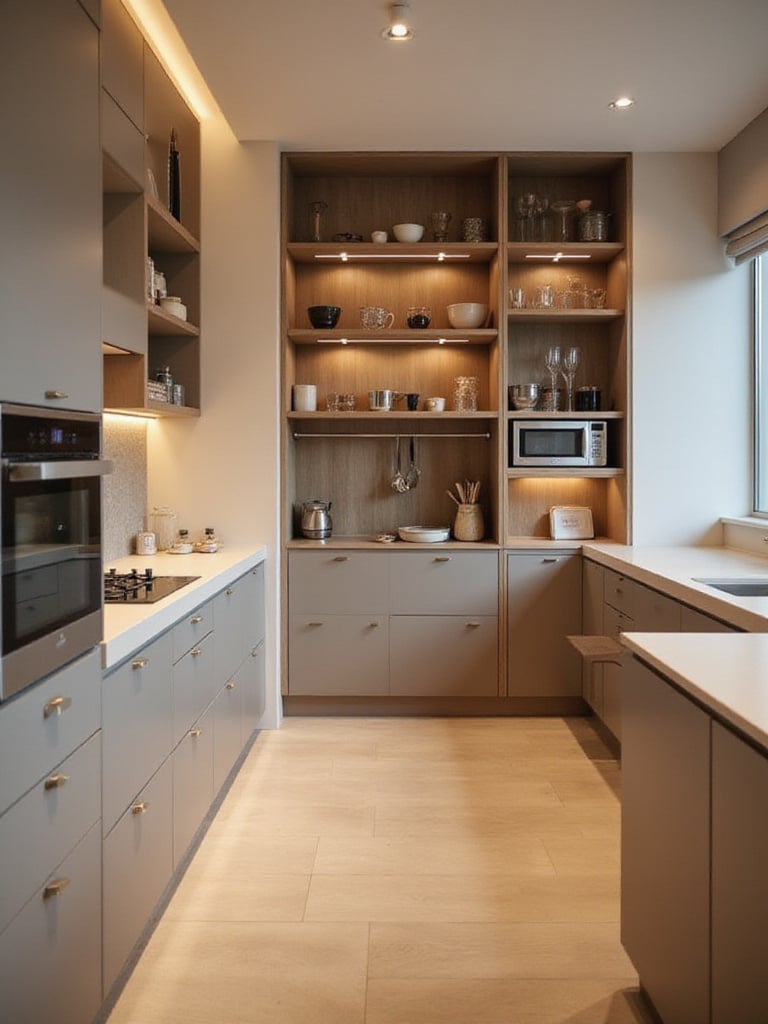
Effective storage thinks vertically and into the corners. We’re talking about appliance garages with retractable doors, deep drawers with custom dividers for pots and lids, and pull-out pantry towers that use every inch of a narrow cabinet. It’s about creating a dedicated “home” for everything. In one kitchen, for a client who was an avid cook with an enormous spice collection, we designed a shallow cabinet with tiered, pull-out shelves. It looked like a solid panel, but it held over 100 spice jars, all perfectly organized and visible.
- Think Inside the Box: Use pull-out towers to take advantage of vertical space. Install a “Magic Corner” or other specialized hardware to make dead corner cabinets useful. And design your island with deep drawers and integrated shelving.
Speaking of the island, let’s make it the true heart of the home.
12. Designing Your Island for Both Work and Play
The modern kitchen island is the ultimate multitasker. It’s a prep station, a dining table, a homework hub, a cocktail bar. It has to be a functional workspace and a social magnet, all at once. A well-designed island creates natural gathering points while still providing ample, dedicated space for cooking.
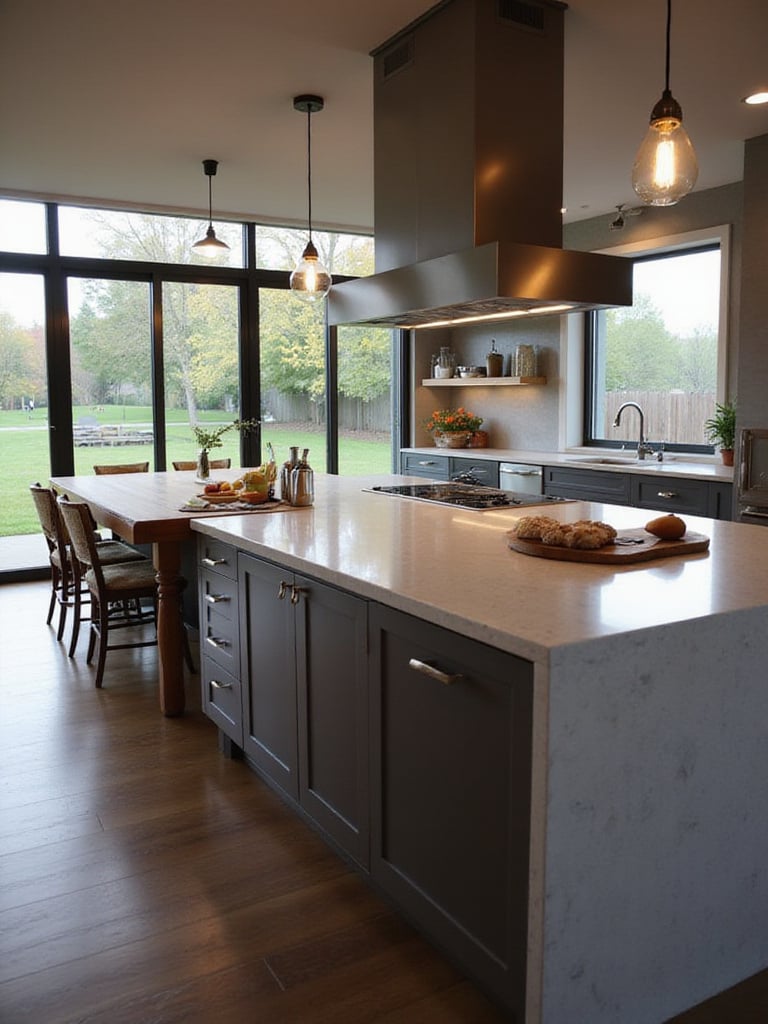
The best island designs create different zones for different activities. Maybe this means a bi-level design, with a lower, 36-inch-high section for chopping and a higher, 42-inch bar-height section for seating. This keeps messy prep work contained and gives guests a comfortable place to perch. Or you could use two different countertop materials to visually signal the shift in function. Most importantly, think about traffic flow. You need enough clearance on all sides for doors to open and for people to pass by without a traffic jam.
- Design Checklist: Does your island need a prep sink or electrical outlets? Factor those in early. Maximize the interior with smart storage. And consider rounding the corners—it’s a small detail that makes it feel much more fluid and inviting to move around.
As we’re designing the island, let’s consider the sink that goes in it.
13. Integrating Your Sink for That Seamless Look
An integrated sink is the purest expression of minimalist kitchen design. By fabricating the sink from the same material as the countertop, you get this beautiful, monolithic surface. It’s a concept that feels both Japanese in its sense of flow and European in its precision manufacturing. The lack of seams or rims makes it incredibly easy to clean—you just wipe everything straight into the sink.
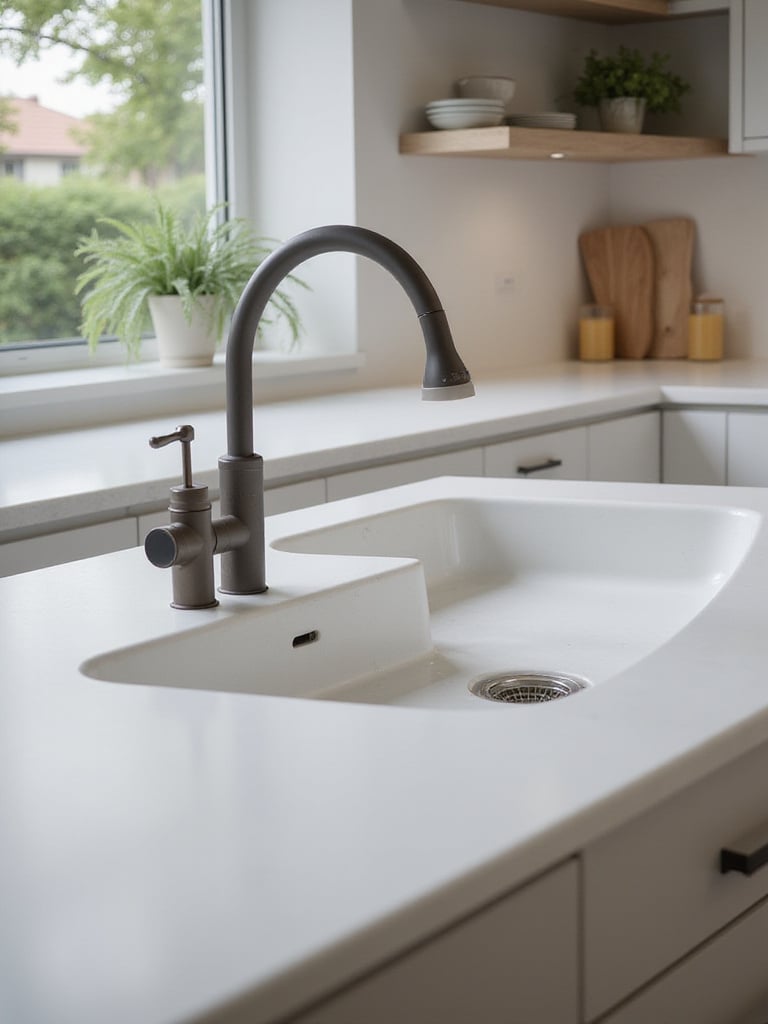
The process depends entirely on the countertop material. Solid surfaces like Corian can be molded for a truly seamless transition. With quartz or stone, it requires a master fabricator to get those invisible joints just right. My personal favorite is with Stainless Steel, where the sink is welded directly into the countertop for an industrial-chic look that is virtually indestructible. The key is to find a fabricator who specializes in this kind of work. It’s not a job for a generalist.
- Go Beyond the Basics: Integrated sinks open up possibilities for custom features, like built-in drainboards with gentle slopes or multi-level basins for washing and rinsing.
When choosing these beautiful materials, let’s also think about their impact.
14. Choosing Sustainable Materials with a Conscience
Choosing sustainable materials is no longer a niche concern; it’s central to responsible, modern design. This approach aligns with the ancient wisdom of living in harmony with nature, while embracing new technologies that give us incredible, eco-friendly options. And often, these sustainable materials are not only better for the planet but also better for your health and more durable.
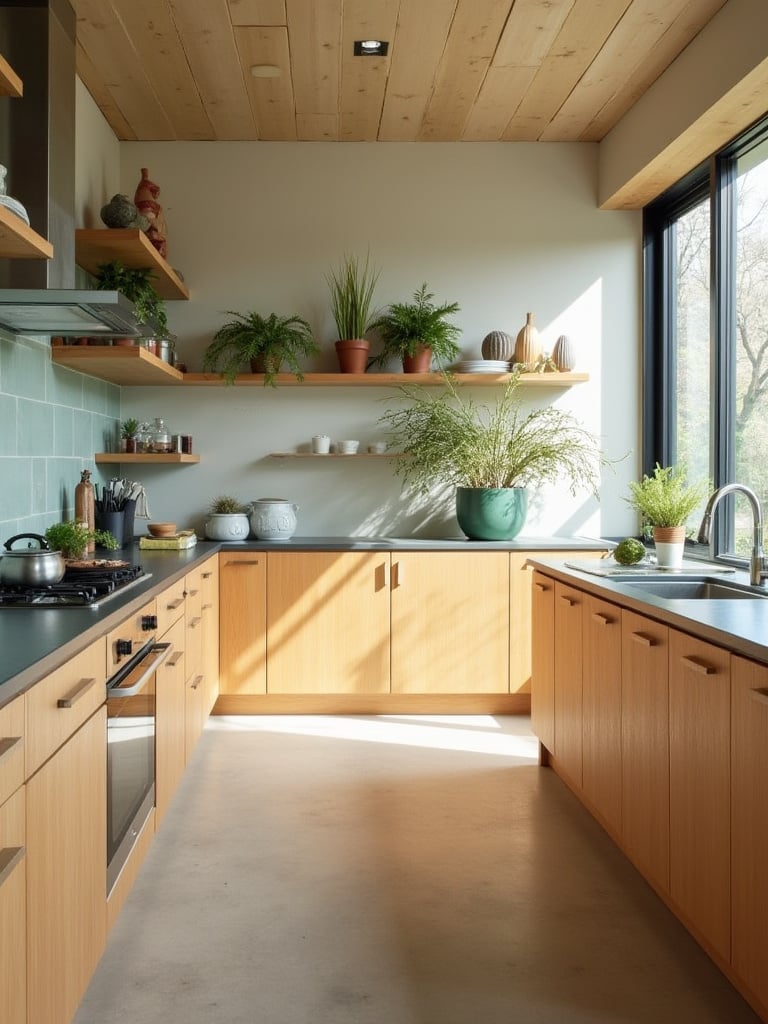
Effective sustainable design is more than just picking a bamboo floor. It’s about looking for third-party certifications like FSC for wood or Greenguard Gold for low-VOC finishes. It’s about sourcing materials locally to cut down on transportation. But I encourage my clients to think even bigger, to consider the entire lifecycle. This means choosing modular cabinets that can be reconfigured later, picking materials that will develop a beautiful patina over time instead of needing to be replaced, and prioritizing timelessness over trends.
- Your Eco-Checklist: Look for certifications. Prioritize materials made within a 500-mile radius. And choose things built to last a lifetime, not just a few years.
Once all the major pieces are in place, it’s time to curate the final layer.
15. Curating Your Decor with a Minimalist’s Eye
Decorating a modern kitchen is an exercise in restraint. Every single item on display must earn its place, either through its undeniable beauty or its essential function. This is part Scandinavian hygge, part Japanese wabi-sabi—finding the beauty in simple, useful, and imperfect things. Think of yourself as a curator of your own small gallery. An uncluttered space is a calm space; that empty counter isn’t a void to be filled, but a moment of quiet.
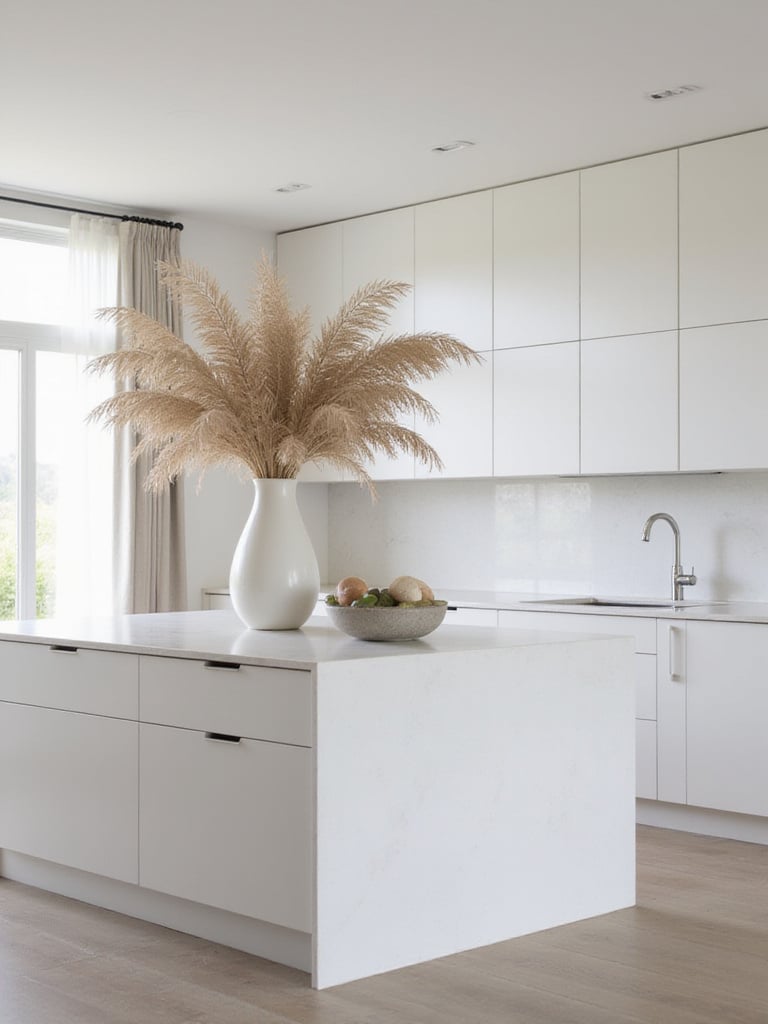
The trick is to choose pieces that are both beautiful and useful. A stunning wooden cutting board can hang on the wall like a piece of art when not in use. A single, hand-thrown ceramic bowl can hold your fruit while being a sculpture in its own right. Instead of displaying all your decor at once, try rotating items seasonally. This keeps the space feeling fresh and prevents that slow creep of clutter.
- My Personal Rule: Quality over quantity, always. Invest in one beautiful, well-made pepper mill instead of five mediocre ones. Choose things you love to touch and use every day. And know when to stop.
To balance all this minimalism, we need to bring in some life.
16. Weaving in Natural Elements for Warmth and Life
To prevent a modern kitchen from feeling cold or clinical, you must invite nature inside. This is the core of biophilic design—the idea that we have an innate need to connect with the natural world. It’s a principle as old as feng shui and as new as a NASA study on air quality. Incorporating natural materials and living plants can genuinely lower stress and make a space feel more grounded and human.
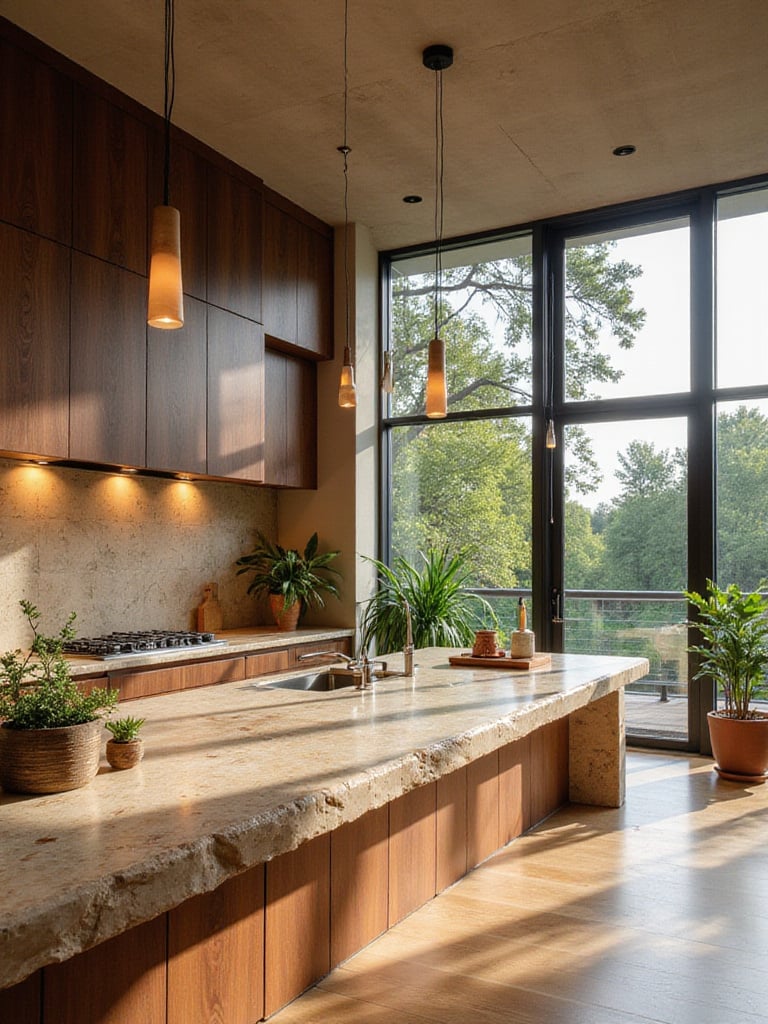
This doesn’t mean turning your kitchen into a jungle. The best natural touches feel intentional. It could be a small herb garden on the windowsill, providing fresh flavors and a splash of green. It might be the live-edge wood on your breakfast bar, or the subtle texture of a slate floor. It’s about the tactile experience—the feel of cool stone, the warmth of wood grain. These are the elements that provide the emotional connection that transforms a house into a home.
- Simple Additions: Choose plants that thrive in kitchen humidity. Incorporate different natural textures—wood, stone, linen, wool. And find small ways to connect to the seasons, like a bowl of autumn gourds or a vase of spring branches.
And with all these beautiful surfaces, let’s make sure they are easy to live with.
17. Prioritizing Easy-to-Clean Surfaces for Real Life
A beautiful kitchen you’re afraid to use is a design failure. Period. This practical wisdom—that form must serve livability—is something I deeply respect in both German and Japanese design. The goal is to choose surfaces that look pristine with minimal effort, so you can spend your time enjoying your kitchen, not endlessly scrubbing it.
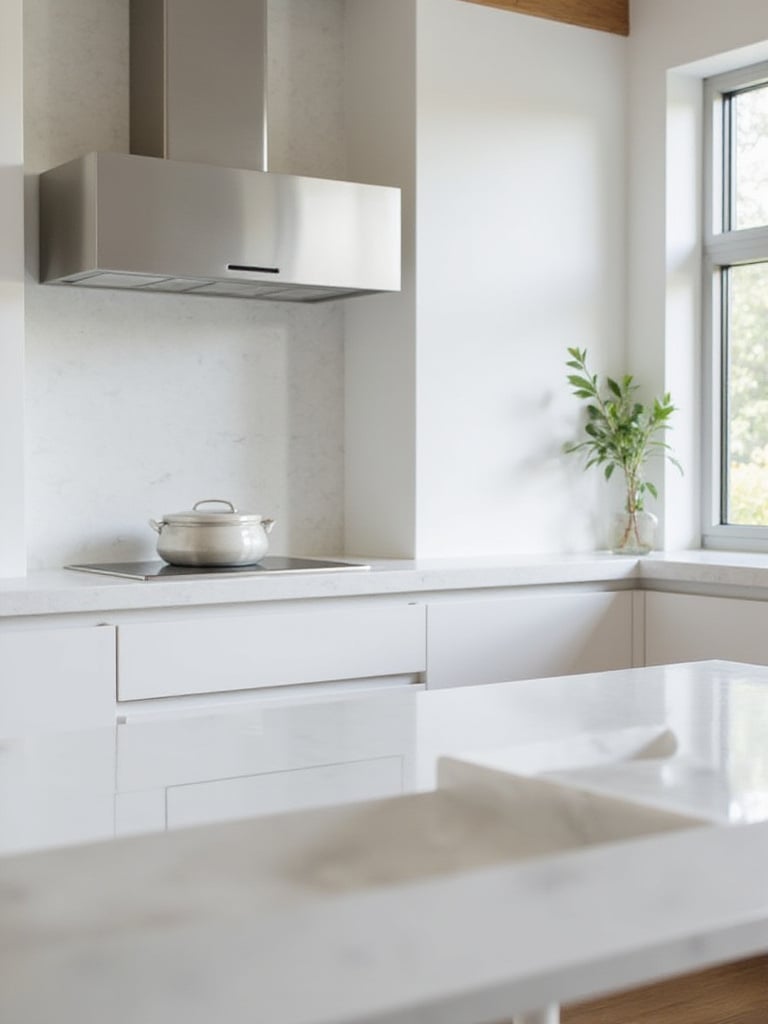
Modern material science has given us some incredible options, like fingerprint-resistant stainless steel and non-porous quartz that laughs at red wine spills. But often, the smartest choice is simply good design: seamless surfaces without grout lines or crevices for grime to hide in. A large, single-basin sink is easier to clean than a double. Matte finishes hide smudges better than high-gloss ones. It’s about making smart, pragmatic choices from the start.
- The Bottom Line: As cleaning expert Melissa Maker says, “The best kitchen surfaces are the ones you forget to worry about.” That’s the goal: to design a space where you can live freely, cook with abandon, and not stress about the mess.
The final two elements are about enhancing what’s already there and thoughtfully managing what we produce.
18. Maximizing Natural Light to Brighten Everything
Natural light is the secret ingredient in every great kitchen. It’s free, it makes every color and material look better, and it connects us to the rhythm of the day. This is something Scandinavian designers, who have to make the most of every sunbeam, understand perfectly. A design that maximizes daylight can drastically cut your electricity bill, but more importantly, it makes the space feel alive and dynamic.
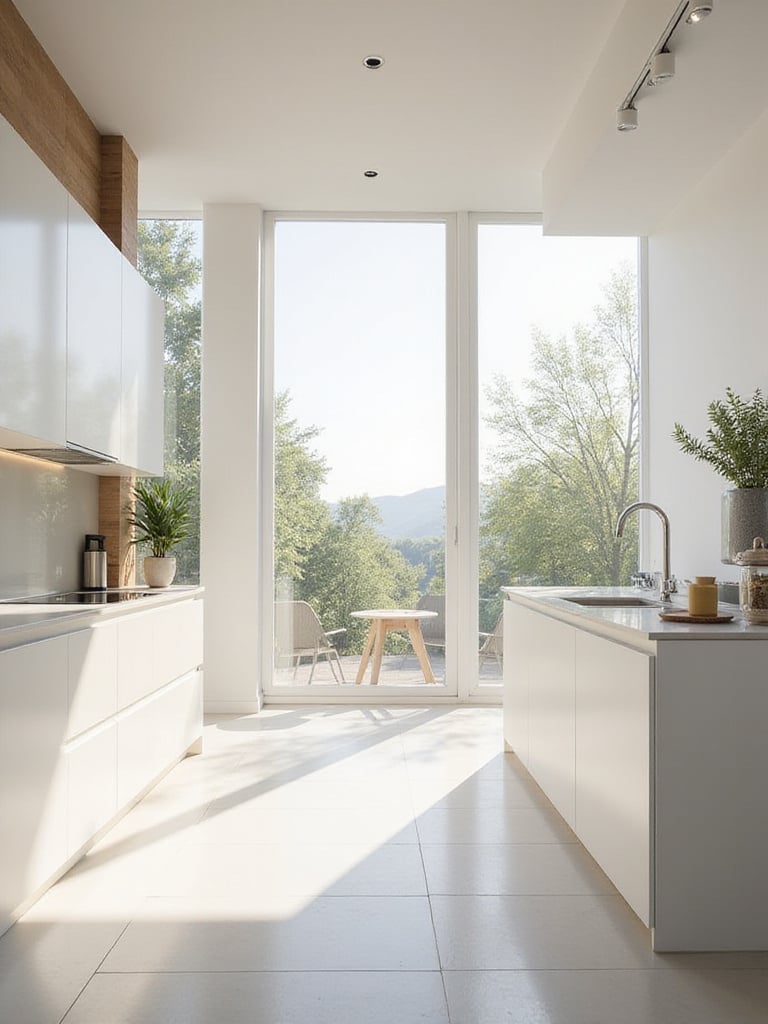
Work with your home’s architecture. Can you enlarge a window? Add a skylight or a solar tube to bring light into the center of the room? Sometimes the best strategy is simply to amplify the light you already have. Use light-colored, reflective surfaces. A glossy backsplash, a polished countertop, or even a strategically placed mirror can bounce light deep into the room, transforming a dark corner into a bright and cheerful spot.
- Light-Bouncing Tricks: Choose window treatments that offer privacy without blocking light (like top-down/bottom-up shades). Use reflective finishes. And consider an interior window or glass door to “borrow” light from an adjacent, brighter room.
And finally, let’s address what we leave behind.
19. Integrating Smart Waste Management for a Tidy, Conscious Kitchen
Let’s be honest: no one wants to look at a bin overflowing with trash and recycling. Modern waste management is about more than just hiding the can. It’s about creating integrated, seamless systems for sorting, compacting, and even composting, all while maintaining the kitchen’s clean aesthetic. This is where environmental consciousness meets smart design. A well-designed system makes recycling and composting an effortless part of your daily workflow, not a chore.
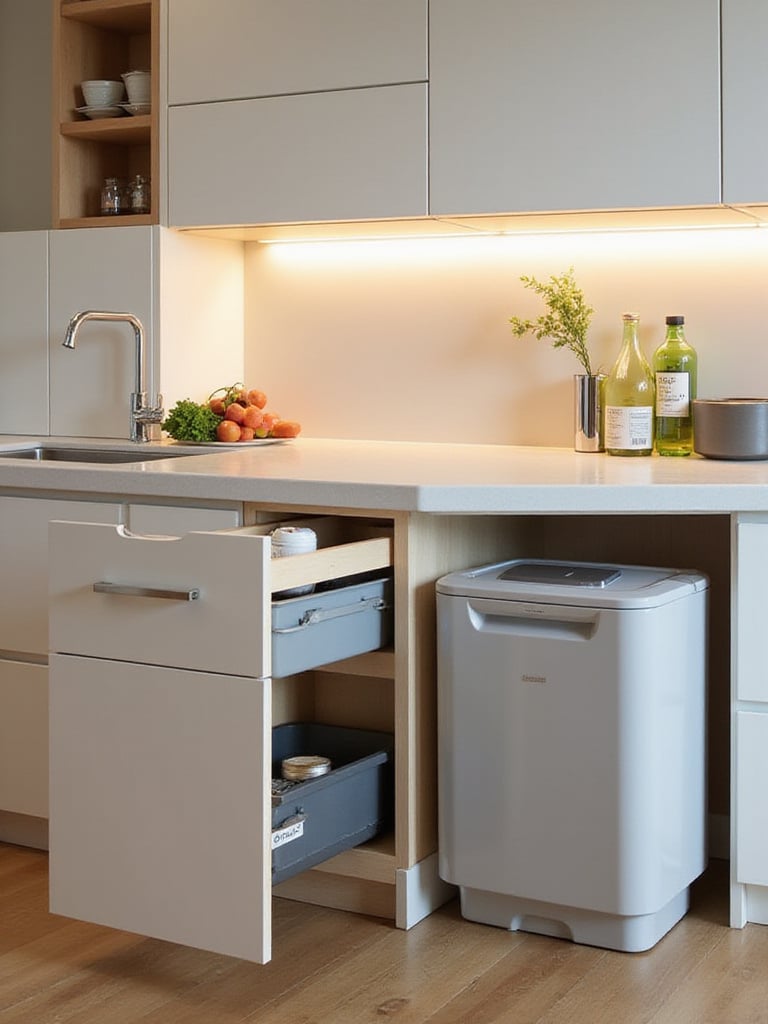
The best solutions are built right into the cabinetry, often in a pull-out drawer near the main prep sink. You can have separate, color-coded bins for trash, paper, plastic, and compost. Some high-end systems even include features like carbon filters for odor control or under-sink composters that accelerate the process. The key is to make it so convenient that doing the right thing is also the easiest thing.
- Your System: Design a system that separates compost, recycling, and trash right at the source. Plan for odor control with sealed lids. And place the whole unit where you produce the most waste—typically next to the sink and prep area.
The Heart of the Matter
Creating your modern kitchen is a journey. As we’ve seen, it’s a conversation between global wisdom and personal needs, between Eastern philosophies of harmony and Western technological innovation. It’s about finding the balance that feels right for you. The most breathtaking kitchens I have had the honor of designing are not the ones that slavishly follow trends, but the ones that are a true reflection of the people who live in them.
As you begin to plan, trust that thoughtful design has the power to improve not just your home, but your daily life. Let your space tell your story—a story of your heritage, your travels, your family, your taste. Create a place where traditions can be honored and new ones can be born, in a setting that is unmistakably, beautifully, and personally yours.






